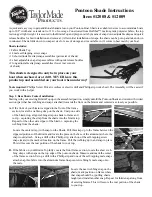
1
06.00
-
-
-
-
ILS
TO.930
T. 5
FONCTIONNEMENT
- Le sondeur
ILS
est monté sur
le couvercle du réservoir. On
fait descendre une sonde dans
un réservoir. Cette sonde est
suspendue à l’extrémité d’un
câble de mesure enroulé sur
une bobine entraînée par un
moteur électrique.
- Lorsque la sonde atteint le pro-
duit, le sens de bobinage com-
mute et la sonde revient à sa
position de départ.
- L’appareil est divisé en deux
compartiments, proches l’un
de l’autre (compartiment de
commande et compartiment
bobine). Seul l’espace réser-
vé à la bobine est relié direc-
tement à l’intérieur du réser-
voir pendant le déroulement du
processus de mesure. Dans
la position initiale, la sonde étan-
che l'ouverture entre l'appa-
reil et le reservoir.
- Pendant la descente, des im-
pulsions sont émises, chaque
impulsion représente une dis-
tance de 10 cm. La quantité
d’impulsions émises représen-
te une mesure pour le niveau
de remplissage. Les impul-
sions peuvent être traitées di-
rectement dans une comman-
de programmé PLC ou dans un
compteur (par ex. ILSMZ100-
4; ILSZ-300, voir “display et
compter de impusion”).
Version avec sortie analogi-
que 0/4 - 20 mA:
- les impulsions de comptage
sont converties en interne en
un signal de contact analogi-
que. Le courant de sortie peut
se régler en fonction de l’ap-
plication, ce qui permet notam-
ment un affichage volumétri-
que adapté à la géométrie du
réservoir. Le signal électrique
est initialisé dès que la sonde
atteint le dessus du produit.
- La procédure de mesure est
initiée par un signal externe,
au moyen d’un contact de tra-
vail, d’un signal 24 V CC ou
d’un timer dans le cas du dé-
part automatique.
- La procédure de mesure est
contrôlée par microproces-
seur. La longueur dévidée de
la sonde est comparée à la
longueur enroulée sur la bobi-
ne. En cas d’écart, un messa-
ge est émis. Ceci garantit que
la sonde se trouve toujours
dans la position finale supé-
rieure.
FUNCTION
- The
ILS
is mounted on top of
the silo. A sensor weight is
lovered into the silo. The sen-
sor weight is mounted at the
end of a measuring rope/tape,
which is wrapped around a
motor-driven rope roller.
- Upon impact on the bulk mate-
rial, the sensor weight returns
to its upper stop .
- The unit is divided into two in-
dependent chambers (rope
chamber and electronic cham-
ber), which are sealed from
each other.
- Only the rope chamber is in
contact with the inside of the
silo during measurement. If the
sensor weight is in the upper
stop position, it seals the open-
ing between the unit and the
silo.
- Pulses are generated during
downward movement and the
number of pulses can be proc-
essed directly in a PLC (pro-
gramable logic controller) or a
(ILSMZ100-4; ILSZ-300; see
chapter on “display and im-
pulse counters”).
Version with
analog output0/4-20mA:
- the pulses are internally con-
verted into an analogue cur-
rent signal. The current signal
can be adjusted specifically.
In this way it is possible to get
a volume-specific signal, suit-
abe to the geometry of the silo.
The current signal is renewed,
when the sensor weight
touches the bulk material.
- Measurement starts with an
external start signal (remote
control) or with an externally
made contact or an external
24V DC signal. To start auto-
matically at a predetermined
period, an internal timer is part
of the standard supply.
- Measurement is controlled by
a microprocessor. A compari-
son between the distance of
the downward moving weight
and the distance of upward
moving weight is carried out.
In case of deviation a signal
output is activated. This guar-
antees that the sensor weight
is always in the upper stop
position.
FUNKTION
- Das
ILS
wird auf dem Behäl-
terdach montiert. Ein Fühlge-
wicht wird in den Behälter ab-
gelassen. Das Fühlgewicht ist
am Ende eines Mess-Seiles/
Bandes befestigt, welches auf
einer elektromotorisch ange-
triebenen Spule aufgewickelt
ist.
- Trifft das Fühlgewicht auf dem
Füllgut auf, wird die Spulrich-
tung umgeschaltet, und das
Gewicht kehrt in seine Aus-
gangslage zurück.
- Das Gerät ist in zwei vonein-
ander dicht getrennte Kam-
mern (Schalt- und Spulenraum)
geteilt. Nur der Spulenraum ist
während des Messvorganges
mit dem Behälterinneren direkt
verbunden. In der Ausgangs-
lage dichtet das Fühlgewicht
die Öffnung zwischen Gerät
und Behälter ab.
- Während der Abwärtsbewe-
gung werden Impulse abgege-
ben. Die Anzahl der abgege-
benen Impulse stellt ein Maß
für den Füllstand dar. Die Im-
pulse können direkt in einer
SPS oder einem Zähler (z.B.
ILSMZ100-4 oder ILSZ-300,
“display und zähler impulse”)
verarbeitet werden.
Version
Analogausgabe
0/4 - 20 mA :
- werden die Zählimpulse intern
in ein analoges Stromsignal
umgewandelt. Der Stromaus-
gang läßt sich anwendungs-
spezifisch einstellen, womit
u.a. eine auf die Behältergeo-
metrie abgestimmte volumetri-
sche Anzeige möglich wird.
Das Stromsignal wird nach
Auftreffen des Fühlgewichtes
auf dem Füllgut aktualisiert.
- Der Messvorgang erfolgt auf
ein externes Startsignal mittels
Schließkontakt, 24 V DC-Sig-
nal oder für automatischen
Start mittels integriertem Timer.
- Der Messvorgang wird mittels
Mikroprozessor überwacht.
Die abgelaufene Länge des
Fühlgewichtes wird mit der
aufgespulten Länge vergli-
chen. Bei Unstimmigkeit wird
eine Meldung ausgegeben.
Dies gewährleistet, daß sich
das Fühlgewicht stets in der
oberen Endlage befindet.
FUNZIONE
- L’
ILS
è installato sulla sommità
del silo. Una sonda viene ab-
bassata nel silo. Tale sonda è
montata all’estremità di una
fune/nastro di misura, avvolta
su una bobina azionata a mo-
tore.
- La sonda, sotto l’impatto del
materiale sfuso, ritorna alla
posizione di arresto superio-
re.
- Il gruppo è diviso in due came-
re indipendenti (camera della
fune e camera elettronica), a
tenuta una rispetto all’altra. La
camera della fune è l’unica a
contatto con l’interno del silo
durante la misurazione. Se la
sonda è in posizione di arre-
sto superiore, sigilla l’apertu-
ra tra il gruppo e il silo.
- Vengono generati impulsi du-
rante il movimento di abbas-
samento e il numero di impulsi
può essere elaborato diretta-
mente da un PLC (controllore
logico programmabile) o da un
contatore (ILSMZ100-4; ILSZ-
300; vedere il capitolo “display
e contatori d’impulso”).
Versione con uscita analo-
gica 0/4-20mA:
- gli impulsi sono convertiti in-
ternamente in un segnale ana-
logico. Si può regolare speci-
ficatamente tale segnale di
corrente. Si può quindi ottene-
re un segnale specifico per il
volume, idoneo alla geometria
del silo. Il segnale si rinnova,
quando la sonda viene a con-
tatto con il materiale sfuso.
- La misurazione inizia con un
segnale di avvio esterno (a co-
mando remoto) o con un se-
gnale esterno a c.c. a 24V. E’
in dotazione un timer interno
per consentire l’avvio automa-
tico in un periodo di tempo pre-
definito.
- La misurazione è comandata
da un microprocessore. Vie-
ne effettuato un confronto tra
la distanza di spostamento
della sonda verso il basso e la
distanza di spostamento della
sonda verso l’alto. In caso di
deviazione, si attiva un segna-
le. Questa situazione garanti-
sce che la sonda sia sempre
in posizione di arresto supe-
riore.
DESCRIPTION AND TECHNICAL CHARACTERISTICS
BESCHREIBUNG UND TECHNISCHE MERKMALE
DESCRIPTION ET CARACTERISTIQUES TECHNIQUES
DESCRIZIONE E CARATTERISTICHE TECNICHE






































